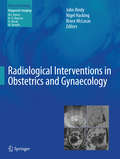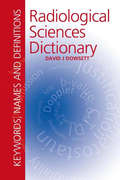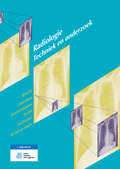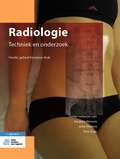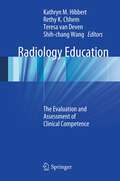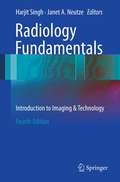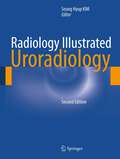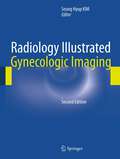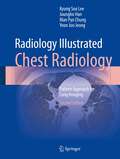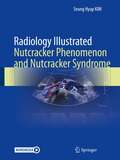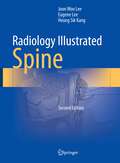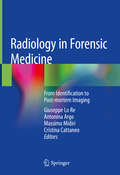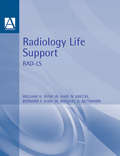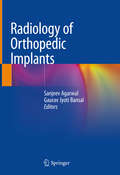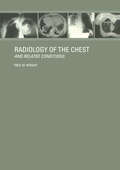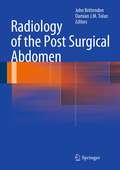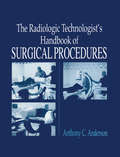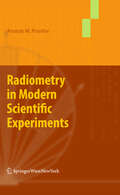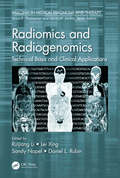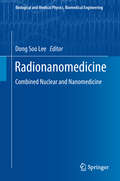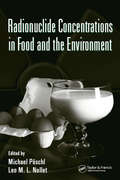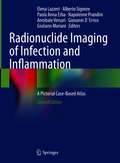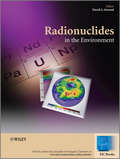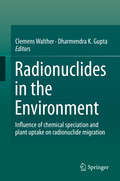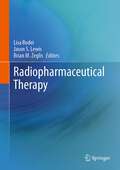- Table View
- List View
Radiological Interventions in Obstetrics and Gynaecology (Medical Radiology)
by John Reidy Nigel Hacking Bruce McLucasThis book provides a state-of-the-art review of the technical and clinical aspects of the vascular interventional radiological (IR) procedures currently employed in obstetrics and gynaecology. A particular focus is on uterine artery embolisation for fibroid disease, which is contrasted with the main alternative uterus-conserving surgical approach of myomectomy, and with ablation therapy. Detailed consideration is also given to the role of embolisation in a variety of other less common conditions, including arteriovenous malformations, post-partum haemorrhage, abnormal placentation and pelvic congestion syndrome. IR procedures are examined from a critical gynaecological perspective and with regard to surgical alternatives. The authors include leading interventional radiologists and gynaecologists from the United Kingdom, Europe and North America.
Radiological Sciences Dictionary: Keywords, names and definitions
by David DowsettThe Radiological Sciences Dictionary is a rapid reference guide for all hospital staff employed in diagnostic imaging, providing definitions of over 3000 keywords as applied to the technology of diagnostic radiology.Written in a concise and easy to digest form, the dictionary covers a wide variety of subject matter, including:a radiation legislati
Radiologie: Techniek en onderzoek
by Jacques Hensen Karen Jaarsveld-Bolman Tom Dam José Dol-Jansen Sija Geers-van GemerenRadiologie maakt deel uit van de serie Medische Beeldvorming en Radiotherapie. De uitgave van deze boeken is een initiatief van het project Samenwerkingsverband Leermiddelen, in samenwerking met de redacties en auteurs uit het werkveld. Dit boek is een vervolg op en afgeleid van de boeken Techniek in de radiologie en Radiodiagnostisch onderzoek. Vanaf 2010 zijn deze twee boeken vervangen door drie delen, die sterk zijn uitgebreid en geactualiseerd:Computertomografie, Radiologie en Magnetic Resonance Imaging. Radiologie bevat een beschrijving van de r#65533;ntgentechniek en instelkunde, en daarnaast een overzicht van belangrijke ontwikkelingen op het gebied van digitalisering en kwaliteitsaspecten van het beroepsveld van de MBB'er (Medisch Beeldvormings- en Bestralingsdeskundige). Deel 1 Techniek beschrijft het basisprincipe van de radiologie en de toepassing hiervan in de praktijk. Nieuwe technische begrippen komen uitgebreid aan bod. Deel 2 gaat in op de strenge eisen op het gebied van kwaliteit en veiligheid die zowel aan de r#65533;ntgenapparatuur als aan de MBB'ers worden gesteld, waarbij ook de pati#65533;ntveiligheid aan bod komt. Deel 3 geeft een uitvoerige beschrijving van de instellingen voor het maken van standaardr#65533;ntgenopnamen met alle benodigde gegevens, ondersteund door fotomateriaal en illustraties. Hierbij is een onderverdeling gemaakt per tractus. Verder is er speciale aandacht voor mammografie, traumatologie en r#65533;ntgenonderzoek bij kinderen. Behalve voor MBB'ers in opleiding is Radiologie ook bij uitstek geschikt voor MBB'ers werkzaam in de radiologie, nucleaire geneeskunde en radiotherapie. Het boek is ook een goede introductie voor radiologen, al dan niet in opleiding, en een betrouwbaar naslagwerk voor artsen in opleiding.
Radiologie: Techniek en onderzoek (Medische beeldvorming en radiotherapie)
by Jacques Hensen John Peeters Tom DamDit boek beschrijft de röntgentechniek en instelkunde, en geeft een overzicht van belangrijke ontwikkelingen op het gebied van digitalisering en kwaliteitsaspecten van het beroepsveld van de MBB’er (Medisch Beeldvormings- en Bestralingsdeskundige). Deel 1 gaat in op het basisprincipe van de radiologie en de toepassing hiervan in de praktijk. Nieuwe technische begrippen komen uitgebreid aan bod. Deel 2 benoemt de strenge eisen op het gebied van kwaliteit en veiligheid die aan de röntgenapparatuur en aan de MBB’ers worden gesteld, waarbij ook de patiëntveiligheid aan bod komt. Deel 3 beschrijft de instellingen voor het maken van standaardröntgenopnamen met alle benodigde gegevens, ondersteund door fotomateriaal en illustraties. Er is een onderverdeling gemaakt per tractus. Verder is er speciale aandacht voor mammografie, traumatologie en röntgenonderzoek bij kinderen. Deze volledig herziene editie is geactualiseerd en aangepast volgens de huidige maatstaven. De techniek is op sommige punten verder ontwikkeld, er zijn verschillende nieuwe onderzoeken bij gekomen en andere onderzoeken zijn obsoleet geworden of vervangen door andere technieken zoals MRI, CT of echografie.Online zijn de teksten en afbeeldingen van het boek ook te raadplegen. Bij dit boek hoort een website die het mogelijk maakt om altijd en overal te studeren of informatie op te zoeken. Ook zijn hier oefenvragen per hoofdstuk beschikbaar die het mogelijk maken om verworven competenties en kennis te toetsen. Radiologie – Techniek en onderzoek maakt deel uit van de serie Medische Beeldvorming en Radiotherapie. Behalve voor MBB’ers in opleiding is dit boek bij uitstek geschikt voor MBB’ers werkzaam in de radiologie, nucleaire geneeskunde en radiotherapie. Het boek is ook een goede introductie voor radiologen, al dan niet in opleiding, en een betrouwbaar naslagwerk voor artsen in opleiding.
Radiology Education
by Kathryn M. Hibbert Rethy K. Chhem Teresa van Van Deven Shih-Chang WangThis book reviews the philosophies, theories, and principles that underpin assessment and evaluation in radiology education, highlighting emerging practices and work done in the field. The sometimes conflicting assessment and evaluation needs of accreditation bodies, academic programs, trainees, and patients are carefully considered. The final section of the book examines assessment and evaluation in practice, through the development of rich case studies reflecting the implementation of a variety of approaches. This is the third book in a trilogy devoted to radiology education. The previous two books focused on the culture and the learning organizations in which our future radiologists are educated and on the application of educational principles in the education of radiologists. Here, the trilogy comes full circle: attending to the assessment and evaluation of the education of its members has much to offer back to the learning of the organization.
Radiology Fundamentals
by Harjit Singh Janet NeutzeRadiology Fundamentals is a concise introduction to the dynamic field of radiology for medical students, non-radiology house staff, physician assistants, nurse practitioners, radiology assistants, and other allied health professionals. The goal of the book is to provide readers with general examples and brief discussions of basic radiographic principles and to serve as a curriculum guide, supplementing a radiology education and providing a solid foundation for further learning. Introductory chapters provide readers with the fundamental scientific concepts underlying the medical use of imaging modalities and technology, including ultrasound, computed tomography, magnetic resonance imaging, and nuclear medicine. The main scope of the book is to present concise chapters organized by anatomic region and radiology sub-specialty that highlight the radiologist's role in diagnosing and treating common diseases, disorders, and conditions. Highly illustrated with images and diagrams, each chapter in Radiology Fundamentals begins with learning objectives to aid readers in recognizing important points and connecting the basic radiology concepts that run throughout the text. It is the editors' hope that this valuable, up-to-date resource will foster and further stimulate self-directed radiology learning--the process at the heart of medical education.
Radiology Illustrated: Uroradiology
by Seung Hyup KimUroradiology is an up-to-date, image-oriented reference in the style of a teaching file that has been designed specifically to be of value in clinical practice. All aspects of the imaging of urologic diseases are covered, and case studies illustrate the findings obtained with the relevant imaging modalities in both common and uncommon conditions. Most chapters focus on a particular clinical problem, but normal findings, congenital anomalies, and interventions are also discussed and illustrated. In this second edition, the range and quality of the illustrations have been enhanced, and many schematic drawings have been added to help readers memorize characteristic imaging findings through pattern recognition. The accompanying text is concise and informative. Besides serving as an outstanding aid to differential diagnosis, this book will provide a user-friendly review tool for certification or recertification in radiology.
Radiology Illustrated: Gynecologic Imaging
by Seung Hyup KimRadiology Illustrated: Gynecologic Imaging is an up-to-date, image-oriented reference in the style of a teaching file that has been designed specifically to be of value in clinical practice. Individual chapters focus on the various imaging techniques, normal variants and congenital anomalies, and the full range of pathology. Each chapter starts with a concise overview, and abundant examples of the imaging findings are then presented. In this second edition, the range and quality of the illustrations have been enhanced, and image quality is excellent throughout. Many schematic drawings have been added to help readers memorize characteristic imaging findings through pattern recognition. The organization of chapters by disease entity will enable readers quickly to find the information they seek. Besides serving as an outstanding aid to differential diagnosis, this book will provide a user-friendly review tool for certification or recertification in radiology.
Radiology Illustrated: Pattern Approach for Lung Imaging (Radiology Illustrated)
by Kyung Soo Lee Joungho Han Man Pyo Chung Yeon Joo JeongThe purpose of this atlas is to illustrate how to achieve reliable diagnoses when confronted by the different abnormalities, or “disease patterns”, that may be visualized on CT scans of the chest. The task of pattern recognition has been greatly facilitated by the advent of high-technology CT such as helical and multidetector CT (MDCT) and dual-energy CT (DECT), and the focus of the book is very much on the role of state-of-the-art MDCT. A wide range of disease patterns and distributions are covered, with emphasis on the typical imaging characteristics of the various focal and diffuse lung diseases. In addition, clinical information relevant to differential diagnosis is provided and the underlying gross and microscopic pathology is depicted, permitting CT–pathology correlation. The entire information relevant to each disease pattern is also tabulated for ease of reference. This book will be an invaluable handy tool that will enable the reader to quickly and easily reach a diagnosis appropriate to the pattern of lung abnormality identified on CT scans. And in this second edition, some more signs and several new diseases and their pattern have been developed and updated. They will be provided with imaging, clinical relevance and CT-pathology correlation. Moreover, the chapters and disease patterns in their order of presentation shall be somewhat changed for readers’ easy legibility and understanding.
Radiology Illustrated: Nutcracker Phenomenon and Nutcracker Syndrome (Radiology Illustrated)
by Seung Hyup KimThe nutcracker phenomenon (NCP) is an accentuated phenomenon of normal subtle compression of the left renal vein (LRV) between the abdominal aorta and superior mesenteric artery. The nutcracker syndrome (NCS) is a syndrome caused by NCP, resulting in hematuria, proteinuria, or left flank pain. The established diagnostic criterion of NCP is a pressure gradient more than 3 mmHG across the compression site, and NCS has been known to be rare, but probably is not rare and in fact quite common. The most important reason why NCS is known to be rare is that the diagnosis is difficult unless invasive venous catheterization and pressure measurement confirm the pressure gradient. Doppler ultrasound is useful in measuring the flow velocity of LRV. From the velocity measured by Doppler ultrasound, we may estimate the pressure gradient. Doppler ultrasound of LRV needs technical skills and experience. Computed tomography (CT) is a popular imaging technique for patients with hematuria, and we need to be familiar with the findings of the NCP at CT. There are variations of NCP associated with vascular anatomy and posture of the patients. This book will illustrate the concepts of NCP and NCS, findings at Doppler ultrasound and CT, and variations of NCP.
Radiology Illustrated: Spine (Radiology Illustrated)
by Joon Woo Lee Eugene Lee Heung Sik KangRadiology Illustrated: Spine is an up-to-date, superbly illustrated reference in the style of a teaching file that has been designed specifically to be of value in clinical practice. Common, critical, and rare but distinctive spinal disorders are described succinctly with the aid of images highlighting important features and informative schematic illustrations. The first part of the book, on common spinal disorders, is for radiology residents and other clinicians who are embarking on the interpretation of spinal images. A range of key disorders are then presented, including infectious spondylitis, cervical trauma, spinal cord disorders, spinal tumors, congenital disorders, uncommon degenerative disorders, inflammatory arthritides, and vascular malformations. The third part is devoted to rare but clinically significant spinal disorders with characteristic imaging features, and the book closes by presenting practical tips that will assist in the interpretation of confusing cases.The second edition is covering updated knowledge about spine imaging interpretation, such as disc nomenclature version 2.0, AO classification for spine trauma, neuromyelitis optica spectrum disorders, covid-19 vaccine related spine disorders, etc. In addition, new edition show a lot of highly qualified spine imaging obtained by recently developed CT and MR machine of high-end technology. A lot of interesting cases representing characteristic imaging features is newly included in the third part.
Radiology in Forensic Medicine: From Identification to Post-mortem Imaging
by Giuseppe Lo Re Antonina Argo Massimo Midiri Cristina CattaneoThis book offers a comprehensive overview of the forensic and radiological aspects of pathological findings, focusing on the most relevant medico-legal issues, such as virtual autopsy (virtopsy), anthropometric identification, post-mortem decomposition features and the latest radiological applications used in forensic investigations. Forensic medicine and radiology are becoming increasingly relevant in the international medical and legal field as they offer essential techniques for determining cause of death and for anthropometric identification. This is highly topical in light of public safety and economic concerns arising as a result of mass migration and international tensions. The book discusses the latest technologies applied in the forensic field, in particular computed tomography and magnetic resonance, which are continuously being updated. Radiological techniques are fundamental in rapidly providing a full description of the damage inflicted to add to witness and medical testimonies, and forensic/radiological anthropology supplies valuable evidence in cases of violence and abuse.Written by international experts, it is of interest to students and residents in forensic medicine and radiology. It also presents a new approach to forensic investigation for lawyers and police special corps as well as law enforcement agencies.
Radiology Life Support (RAD-LS): A Practical Approach
by William Bush Jr'Radiology Life Support' focuses on the adverse effects and life-threatening emergencies caused by reactions to the contrast media used in every modern radiology department. Such reactions are relatively infrequent yet can be severe and are therefore difficult to identify and then handle safely without training. All radiologists will experience at least a few such reactions throughout their career. This book teaches proper recognition and treatment of adverse contrast reactions, proper use of sedation and analgesic agents, proper management of an airway in an emergency situation and principle concepts in basic and advanced life support (including early defibrilation). The text is based on the successful training course run by the editors and sponsored by the American Roentgen Ray Society. Adverse reactions to contrast agents are somewhat difficult for physicians without practice to identify and then handle effectively. This volume is a useful aid to the identification process.
Radiology of Orthopedic Implants
by Sanjeev Agarwal Gaurav Jyoti BansalThere is an ever-expanding range of implants used in Orthopaedic Surgery. Nearly 200,000 joint replacement procedures are done in UK every year. The performance of these implants is assessed on radiographs. This is of interest to Orthopaedic surgeons and Radiologists alike. Information on interpretation of these radiographs is not readily available in an easily readable format. This book will assist both trainees and practicing orthopedic surgeons and radiologists in assessing the radiologic appearance of implants and their potential for future performance.
Radiology of the Chest and Related Conditions
by F W WrightThe book presents a comprehensive overview of the various disease processes affecting the chest and related abnormalities. It discusses biopsy and bronchography, as well as a variety of imaging techniques including radiography, fluoroscopy, tomography, and ultrasound.
Radiology of the Post Surgical Abdomen
by Damian J.M. Tolan John BrittendenA comprehensive description of the most common abdominal operations involving the gastrointestinal tract, pancreas, liver and genitourinary systems, illustrated with artists' drawings and images of normal post operative anatomy. The complications associated with each procedure will be in table format consisting of text alongside imaging examples. There will also be teaching points included. The book will be divided into nine chapters.
The Radiology Technologist's Handbook to Surgical Procedures
by AnthonyC AndersonIn the past several years, the rapid development of sophisticated imaging modalities has made radiology the fastest growing specialty in medicine. It is important for the radiologic technologist to keep pace with technology's advancements. The influx of freestanding outpatient facilities and the demands of insurance companies, HMOs and third party reimbursement have brought about change. Medical facilities have begun to call upon nurses, surgical technicians, and other non-radiologic personnel to assist with patient positioning during surgical procedures requiring imaging-creating a need for a concise, how-to guide to performing surgical procedures. The Radiology Technologist's Handbook to Surgical Procedures provides a quick reference for using fluoroscopic and x-ray equipment during surgical procedures. This book includes detailed descriptions and photographs taken in actual clinical settings.By using this manual as a foundation, the radiologic technologist will be able to master many of the operating room x-ray procedures.
Radiometry in Modern Scientific Experiments
by Pravilov AnatolyThe reader is provided with information about methods of calibration of light sources and photodetectors as well as responsiveness of spectral instruments ranging from near infrared to vacuum UV spectral, 1200 - 100 nm, and radiation intensities of up to several quanta per second in absolute and arbitrary units. The author describes for the first time original methods of measurements they created and draws upon over 40 years of experience in working with light sources and detectors to provide accurate and precise measurements. This book is the first to cover these aspects of radiometry and is divided into seven chapters that examine information about terminology, units, light sources and detectors, methods, including author's original ones, of absolute calibration of detectors, spectral instruments responsiveness, absolute measurements of radiation intensity of photoprocesses, and original methods of their study. Of interest to researchers measuring; luminescence spectra, light intensities from IR to vacuum UV, spectral range in wide-light intensity ranges, calibrate light sources and detectors, absolute or relative quantum yields of photoprocess determination.
Radiomics and Radiogenomics: Technical Basis and Clinical Applications (Imaging in Medical Diagnosis and Therapy)
by Ruijiang Li, Lei Xing, Sandy Napel and Daniel L. RubinRadiomics and Radiogenomics: Technical Basis and Clinical Applications provides a first summary of the overlapping fields of radiomics and radiogenomics, showcasing how they are being used to evaluate disease characteristics and correlate with treatment response and patient prognosis. It explains the fundamental principles, technical bases, and clinical applications with a focus on oncology. The book’s expert authors present computational approaches for extracting imaging features that help to detect and characterize disease tissues for improving diagnosis, prognosis, and evaluation of therapy response. This book is intended for audiences including imaging scientists, medical physicists, as well as medical professionals and specialists such as diagnostic radiologists, radiation oncologists, and medical oncologists. Features Provides a first complete overview of the technical underpinnings and clinical applications of radiomics and radiogenomics Shows how they are improving diagnostic and prognostic decisions with greater efficacy Discusses the image informatics, quantitative imaging, feature extraction, predictive modeling, software tools, and other key areas Covers applications in oncology and beyond, covering all major disease sites in separate chapters Includes an introduction to basic principles and discussion of emerging research directions with a roadmap to clinical translation
Radionanomedicine: Combined Nuclear And Nanomedicine (Biological and Medical Physics, Biomedical Engineering)
by Dong Soo LeeThis book describes radionanomedicine as an integrated medicine using exogenous and endogenous This book describes radionanomedicine as an integrated approach that uses exogenous and endogenous nanomaterials for in vivo and human applications. It comprehensively explains radionanomedicine comprising nuclear and nanomedicine, demonstrating that it is more than radionanodrugs and that radionanomedicine also takes advantage of nuclear medicine using trace technology, in which miniscule amounts of materials and tracer kinetic elucidate in vivo biodistribution. It also discusses exogenous nanomaterials such as inorganic silica, iron oxide, upconversion nanoparticles and quantum dots or organic liposomes labelled with radioisotopes, and radionanomaterials used for targeted delivery and imaging for theranostic purposes. Further, it examines endogenous nanomaterials i.e. extracellular vesicles labelled with radioisotopes, known as radiolabelled extracellular vesicles, as well as positron emission tomography (PET) and single photon emission computed tomography (SPECT), which elucidate the biodistribution and potential for therapeutic success.
Radionuclide Concentrations in Food and the Environment
by Leo M. L. Nollet Michael PoschlAs radiological residue, both naturally occurring and technologically driven, works its way through the ecosystem, we see its negative effects on the human population. Radionuclide Concentrations in Food and the Environment addresses the key issues concerning the relationship between natural and manmade sources of environmental radioactivity
Radionuclide Imaging of Infection and Inflammation: A Pictorial Case-Based Atlas
by Elena Lazzeri Alberto Signore Paola Anna Erba Napoleone Prandini Annibale Versari Giovanni D´Errico Giuliano MarianiThis atlas explores the latest advances in radionuclide imaging in the field of inflammatory diseases and infections, which now typically includes multimodality fusion imaging (e.g. in SPECT/CT and in PET/CT). In addition to describing the pathophysiologic and molecular mechanisms on which the radionuclide imaging of infection/inflammation is based, the clinical relevance and impact of such procedures are demonstrated in a collection of richly illustrated teaching cases, which describe the most commonly observed scintigraphic patterns, as well as anatomic variants and technical pitfalls. Special emphasis is placed on using tomographic multimodality imaging to increase both the sensitivity and specificity of radionuclide imaging.The aim of the second edition of this book is to update the first (published in 2013) by reflecting the changes in this rapidly evolving field. Particular attention is paid to the latest advances in the radionuclide imaging of infection and inflammation, including the expanding role of hybrid imaging with [18F]FDG PET/CT SPECT/CT, without neglecting new radiotracers proposed for the imaging of infection/inflammation. Written by respected experts in the field, the book will be an invaluable tool for residents in nuclear medicine, as well as for other specialists.
Radionuclides in the Environment
by David A. AtwoodNuclear energy is the one energy source that could meet the world's growing energy needs and provide a smooth transition from fossil fuels to renewable energy in the coming decades and centuries. It is becoming abundantly clear that an increase in nuclear energy capacity will, and probably must, take place.However, nuclear energy and the use of radionuclides for civilian and military purposes lead to extremely long-lived waste that is costly and highly problematic to deal with. Therefore, it is critically important ot understand the environmental implications of radionuclides for ecosystems and human health if nuclear energy is to be used to avoid the impending global energy crisis. The present volume of the EIC Books series addresses this critical need by providing fundamental information on environmentally significant radionuclides.The content of this book was developed in collaboration with many of the authors of the chapters. Given the enormity of the subject the Editor and the Authors had to be judicious in selecting the chapters that would appropriately encompass and describe the primary topics, particularly those that are of importance to the health of ecosystems and humans. The resulting chapters were chosen to provide this information in a book of useful and appropriate length. Each chapter provides fundamental information on the chemistry of the radionuclides, their occurrence and movement in the enivornment, separation and analyses, and the technologies needed for their remediation and mitigation. The chapters are structured with a common, systematic format in order to facilitate comparions between elements and groups of elements.About EIC BooksThe Encyclopedia of Inorganic Chemistry (EIC) has proved to be one of the defining standards in inorganic chemistry, and most chemistry libraries around the world have access either to the first of second print editon, or to the online version. Many readers, however, prefer to have more concise thematic volumes, targeted to their specific area of interest. This feedback from EIC readers has encouraged the Editors to plan a series of EIC Books, focusing on topics of current interest. They will appear on a regular basis, and will feature leading scholars in their fields. Like the Encyclopedia, EIC Books aims to provide both the starting research student and the confirmed research worker with a critical distillation of the leading concepts in inorganic and bioinorganic chemistry, and provide a structured entry into the fields covered.This volume is also available as part of Encyclopedia of Inorganic Chemistry, 5 Volume Set.This set combines all volumes published as EIC Books from 2007 to 2010, representing areas of key developments in the field of inorganic chemistry published in the Encyclopedia of Inorganic Chemistry. Find out more.
Radionuclides in the Environment
by Clemens Walther Dharmendra K. GuptaThis book provides extensive and comprehensive information to researchers and academicians who are interested in radionuclide contamination, its sources and environmental impact. It is also useful for graduate and undergraduate students specializing in radioactive-waste disposal and its impact on natural as well as manmade environments. A number of sites are affected by large legacies of waste from the mining and processing of radioactive minerals. Over recent decades, several hundred radioactive isotopes (radioisotopes) of natural elements have been produced artificially, including 90Sr, 137Cs and 131I. Several other anthropogenic radioactive elements have also been produced in large quantities, for example technetium, neptunium, plutonium and americium, although plutonium does occur naturally in trace amounts in uranium ores. The deposition of radionuclides on vegetation and soil, as well as the uptake from polluted aquifers (root uptake or irrigation) are the initial point for their transfer into the terrestrial environment and into food chains. There are two principal deposition processes for the removal of pollutants from the atmosphere: dry deposition is the direct transfer through absorption of gases and particles by natural surfaces, such as vegetation, whereas showery or wet deposition is the transport of a substance from the atmosphere to the ground by snow, hail or rain. Once deposited on any vegetation, radionuclides are removed from plants by the airstre am and rain, either through percolation or by cuticular scratch. The increase in biomass during plant growth does not cause a loss of activity, but it does lead to a decrease in activity concentration due to effective dilution. There is also systemic transport (translocation) of radionuclides within the plant subsequent to foliar uptake, leading the transfer of chemical components to other parts of the plant that have not been contaminated directly.
Radiopharmaceutical Therapy
by Lisa Bodei Jason S. Lewis Brian M. ZeglisThis book covers foundational topics in the emerging field of radiopharmaceutical therapy. It is divided into three sections: fundamentals, deeper dives, and special topics. In the first section, the authors examine the field from a bird’s-eye view, covering topics including the history of radiopharmaceutical therapy, the radiobiology of radiopharmaceutical therapy, and the radiopharmaceutical chemistry of both metallic and non-metallic radionuclides. The second section provides a more in-depth look at specific radiotherapeutics. Chapters include broader discussions of the different platforms for radiopharmaceutical therapy as well as more focused case studies covering individual radiotherapeutics. The third and final section explores a number of areas for further study, including medical physics, artificial intelligence, in vivo pretargeting, theranostic imaging, and the regulatory review process for radiotherapeutics.This book is the first of its kind and is useful for a broad audience of scientists, researchers, physicians, and students across a range of fields, including biochemistry, cancer biology, nuclear medicine, radiology, and radiation oncology.
